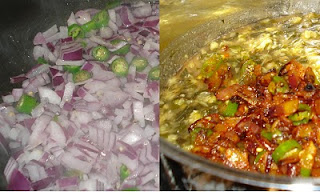Ingredients:
1.5 rice cooker cups Pesara pappu/ Dhuli moong/ Split yellow moong
1/2 Tsp Turmeric
1 bunch Totakura/ Cholai/ Amaranth greens
2 Tbsp Tamarind paste
1 Tsp Salt
1 Tsp Sugar
1 sprig Cilantro
For tempering:
1 Tbsp Oil
1 Tsp Avalu
1 Tsp Jheera
4 Dry red chillies broken into pieces
1/2 Tsp Heeng
4 Curry leaves
3 Green chillies chopped
1 Medium Onion chopped fine
1/2 Garlic clove, pounded
Method:
1. Remove the leaves from the Totakura and wash in cold running water, leave to drain in a colander. The stalks can be used to make Totakura kadalu pulusu.
2. Boil pesara pappu until it is soft and add turmeric. (You may use the directions of Mudda pappu, but keep in mind that pesara pappu is softer & takes less time, so adjust the water/timing.) Set aside.

3. Chop the Totakura by taking a clump of leaves and cutting into them lengthwise & breadthwise so that they are fine chopped. Also chop the onion.
4. Boil the chopped Totakura in 1" water until half done (approx. 7 minutes), add tamarind juice, salt and sugar, and boil again until fully done (approx. a further 7 minutes).
5. Add the boiled pesara pappu into the boiled greens and thoroughly mix in.
6. Fry chopped onions & green chillies in a teaspoon of oil, mix in the pounded garlic paste and fry until brown. Pour into the Totakura-pesara pappu.
7. Tempering:
Heat oil and add mustard seeds. When they splutter, add Jheera, dry red chilli pieces, Heeng and Curry leaves.
8. Pour the tempering over the Totakura-pesara pappu.
9. Let the tempering & fried onions rest over the pappu, mix in just before serving. You may also add some chopped Cilantro.
Serve with hot rice with a generous topping of ghee.
Suggestions/Variations:
1. Pesara pappu is an easy-to-cook pappu which softens rapidly. Hence, if you want to preserve the texture of the grains without letting them get mashed, you may avoid pressure cooking, boil it in a pot of water.
2. The onions & green chillies may be boiled along with the totakura without frying separately if you want to cut down on oil or cook quickly.
3. Some people prefer to add some chopped tomatoes as souring agent along with tamarind. Or, slices of tomatoes can be arranged for garnishing.
4. Traditional brahmans do not consume garlic/onions, they are optional ingredients.
Culture & Health:
Totakura belongs to the Amaranth family, a species of hardy plants which grow rapidly. The plant is highly tolerant to weather conditions and can grow even in arid soil. A single flower head can contain upto half a million tiny beady seeds that are rich in protein and amino acids. Native south American tribes used to consume the flour from the seeds of this plant, so do some African peoples. In India, it is usually consumed as greens. The Amaranth is thought to be the crop of the future, the boon for poor countries since it can be quickly cheaply cultivated with its tremendous health benefits.
The greens are a rich source of vitamins and minerals. However, Amaranth is similar to spinach in that it has high oxalic acid content, and not advisable for those who suffer from gout/kidney disorders.
It is also not advisable to reheat amaranth greens since the chemicals in it undergo undesirable changes when reheated.
Totakura comes in two varieties: one with red stalks/leaves, one with creamy green stalks. The red variety that I used is more delicious & better for health than the green one.
Trivia:
This is my mother's recipe, those are her hands chopping the greens, I was the honest photographer harassing her to pose properly!
Totakura has fond childhood memories for me, Tittu brought back seeds from her village fields, and we planted them in our backyard kitchen garden. I watched the flower beds every single day, watering them with care, waiting eagerly for the first shoots to sprout.. Then when the amaranth grew, we used to pluck the leaves fresh and make kura/pappu, I used to be so proud, that a vegetable I grew was feeding my family!! :-D I could say totakura was my pet plant!!











Vineeta! This is may favorate. Memu Bangalore lo vunnappudu ekkuva ga chesedaanni.
ReplyDeleteMy favourite too pinni, it used to grow in our kitchen garden in Delhi, Tittu used to pluck fresh & make :-)
ReplyDelete